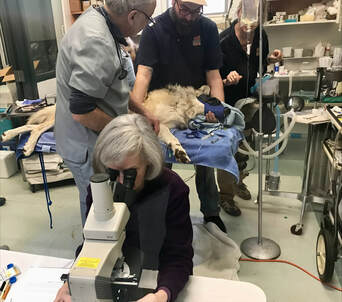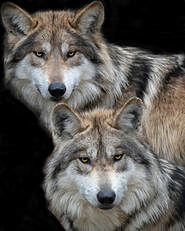 BRIDGEPORT, Conn. – March 2, 2023– Connecticut’s Beardsley Zoo, one of 57 zoos nationwide with Mexican grey wolves in its collection, recently welcomed Cheryl Asa, Ph.D., as part of the Association of Zoos and Aquariums (AZA)’s Mexican Wolf Recovery Program. The bi-national Recovery Program is managed by the AZA’s Species Survival Plan (SSP) in concert with the U.S. Fish and Wildlife Service (USFWS) and Mexican counterparts. Asa, a reproduction advisor in the recovery program and affiliate scientist of the Saint Louis Zoo, came to Bridgeport with her colleagues Rebecca Bose and Louisa Gagliardi from the Wolf Conservation Center to collect semen samples from the Zoo’s two male Mexican grey wolves. Declared extinct in the wild in 1980, the Mexican grey wolf (Canis lupus baileyi), known as “el lobo,” faces ongoing genetic threats to its survival. The current Mexican grey wolf population comes from just seven original “founders,” wolves captured by three private breeders before their numbers plummeted. Genetic diversity suffered as those separate pairs of wolves were inbred. Genetic analyses and careful breeding after zoos in the U.S. and Mexico acquired the wolves and initiated the recovery program has created a genetically healthier population.  “The semen collection is important because it gives us the ability to add a male’s genes to the population even after he dies,” said Asa. “We can accomplish genetic management without physically moving wolves, which can disrupt pair bonds in a monogamous species that mates for life.” “Our Mexican grey wolves are ambassadors for their species. Unless people can see and appreciate these animals, there is little support to protect them in the wild. In accredited zoos, they are provided with professional care and often live much longer lives, providing breeding opportunities to help sustain their numbers,” said Zoo Director Gregg Dancho. “We’re proud to do our part to help save this important species, one of the most endangered mammals in the country.” In 1990, USFWS designated the Saint Louis Zoo Research Department as the headquarters for a frozen semen bank with responsibility for evaluating fertility in individual males. Males are chosen for banking each year based on their genetic value to the population and their location around the country. USFWS estimates that there were 241 Mexican grey wolves in the wild at the end of 2022, but the population’s numbers remain well below recovery objectives and genetic management remains critical. Currently, zoos and wolf conservation centers in the U.S. and Mexico are home to 366 Mexican wolves. The population in zoos is more genetically balanced than the population in the wild, making it important to monitor and release wolves with genes that can help restore genetic balance. In 1998, the U.S. Fish and Wildlife Service released 11 Mexican gray wolves back into the wild in Arizona and New Mexico, in an effort to restore balance to the Southwest’s ecosystems under the Endangered Species Act. Returning the Mexican gray wolf to the wild was a significant milestone for wildlife conservation efforts. Wolves contribute to the health of the environment by keeping deer, elk and javelina populations in check, preventing these animals from population growth that results in overgrazing and the destruction of habitat that other species depend upon. More than a million wolves were killed in the U.S. between 1850 and 1900. In 1907, a call was made for the extinction of the entire species. Throughout the wolf’s history, they have been hunted and reviled due to fear and misunderstanding. In addition to the Mexican grey wolf population’s genetic diversity issue, the wolves face inadequate recovery habitat in the wild, and conflict with humans when wolves wander past their restricted boundaries. About Connecticut’s Beardsley Zoo Let Your Curiosity Run Wild! Connecticut’s only zoo, celebrating its 101st year, features 350 animals representing primarily North and South American and Northern Asian species. Guests won’t want to miss our Amur tiger and leopards, maned wolves, Mexican gray wolves, and red wolves. Other highlights include our Spider Monkey Habitat, the prairie dog exhibit, and the Pampas Plain with giant anteaters and Chacoan peccaries. Guests can grab a bite from the Peacock Café and eat in the Picnic Grove. As an accredited member of the Association of Zoos and Aquariums (AZA) and participant in its Species Survival Plan (SSP) programs, the non-profit Zoo is committed to the preservation of endangered animals and wild habitats. Tickets must be purchased on the Zoo’s website at beardsleyzoo.org. Comments are closed.
|
ContactConnecticut’s Beardsley Zoo appreciates the support it receives from local, regional and national media outlets. Media representatives are invited to tour Archives
July 2024
Categories |
Connecticut’s Beardsley Zoo is dedicated to acquainting a diverse public to the delicate balance that exists between living things and their environment.
Connecticut's Beardsley Zoo is a 501(c)(3) not for profit owned and operated by the Connecticut Zoological Society.
Connecticut's Beardsley Zoo is a 501(c)(3) not for profit owned and operated by the Connecticut Zoological Society.
© 2022 Connecticut's Beardsley Zoo

 RSS Feed
RSS Feed





